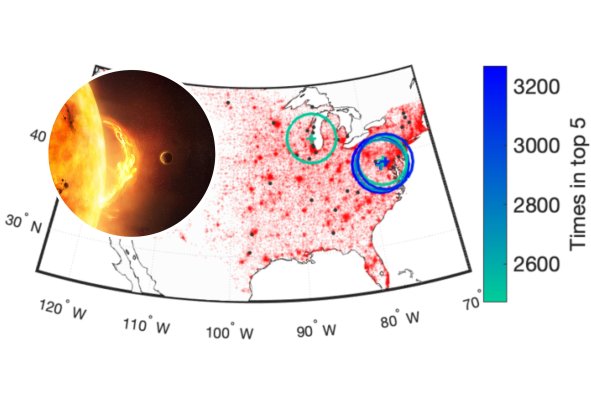Scientists have discovered oxygen is being produced extremely deep below the ocean's surface, changing how we think about life at the bottom of the sea.
Researchers discovered the presence of strange "nodules" on the ocean floor at a depth of about 13,000 feet, and they are capable of producing oxygen in total darkness, according to a new paper in the journal Nature Geoscience.
This "dark oxygen" challenges our current ideas about how life began and also has far-reaching implications for human activity on the ocean floor.
We usually think of oxygen in the ocean as being produced only by plants and algae, which use energy from sunlight to convert carbon dioxide into oxygen via photosynthesis. In their paper, the researchers describe how they detected oxygen being produced in the depths of the Pacific in an area known as the Clarion-Clipperton Zone, which mystified them.
"When we first got this data, we thought the sensors were faulty because every study ever done in the deep sea has only seen oxygen being consumed rather than produced," said Andrew Sweetman, an ecologist and biogeochemist at the Scottish Association for Marine Science, in a statement. "We would come home and recalibrate the sensors, but, over the course of 10 years, these strange oxygen readings kept showing up."
"We decided to take a back-up method that worked differently to the optode sensors we were using. When both methods came back with the same result, we knew we were onto something ground-breaking and unthought-of," he said.
The researchers were assessing the potential impacts of deep-sea mining, which is the process used to gather nodules from the ocean floor. These polymetallic nodules are rich in valuable metals such as nickel, copper, cobalt, manganese and rare earth elements, which are essential for various industrial applications, including the manufacture of lithium-ion batteries.
"The polymetallic nodules that produce this oxygen contain metals such as cobalt, nickel, copper, lithium and manganese—which are all critical elements used in batteries," said study co-author Franz Geiger, a Northwestern University chemistry professor, in the statement.
"Several large-scale mining companies now aim to extract these precious elements from the seafloor at depths of 10,000 to 20,000 feet below the surface," Geiger said.
The researchers discovered that these nodules were able to make oxygen deep beneath the waves. They found that the nodules were carrying a high electric charge, meaning that only 1.5 volts of electricity would be needed for them to act like a battery and electrolyze molecules of water, splitting them into oxygen and hydrogen. They then found that some had up to 0.95 volts on their surfaces, with higher voltages possible if the nodules were clustered together.
"It appears that we discovered a natural 'geobattery,'" Geiger said. "These geobatteries are the basis for a possible explanation of the ocean's dark oxygen production."
This discovery that the nodules may be a source of oxygen for the deep sea has major implications in terms of how life on our planet may have begun.
"For aerobic life to begin on the planet, there had to be oxygen and our understanding has been that Earth's oxygen supply began with photosynthetic organisms," Sweetman said.
"But we now know that there is oxygen produced in the deep sea, where there is no light. I think we therefore need to revisit questions like: where could aerobic life have begun?" he said.
Nicholas Owens, director of the Scottish Association for Marine Science, agreed. "In my opinion, this is one of the most exciting findings in ocean science in recent times," he said in the statement.
"The discovery of oxygen production by a non-photosynthetic process requires us to rethink how the evolution of complex life on the planet might have originated," he continued.
"The conventional view is that oxygen was first produced around three billion years ago by ancient microbes called cyanobacteria and there was a gradual development of complex life thereafter. The potential that there was an alternative source requires us to have a radical rethink," Owens said.
The nodules' role in marine ecosystems may be much more significant than first thought, meaning that deep-sea mining to harvest the nodules could have unknown and potentially disastrous effects.
"We need to rethink how to mine these materials, so that we do not deplete the oxygen source for deep-sea life," Geiger said.
"In 2016 and 2017, marine biologists visited sites that were mined in the 1980s and found not even bacteria had recovered in mined areas," he continued. "In unmined regions, however, marine life flourished.
"Why such 'dead zones' persist for decades is still unknown. However, this puts a major asterisk onto strategies for sea-floor mining as ocean-floor faunal diversity in nodule-rich areas is higher than in the most diverse tropical rainforests," Geiger said.
Do you have a tip on a science story that Newsweek should be covering? Do you have a question about dark oxygen? Let us know via science@newsweek.com.
Disclaimer: The copyright of this article belongs to the original author. Reposting this article is solely for the purpose of information dissemination and does not constitute any investment advice. If there is any infringement, please contact us immediately. We will make corrections or deletions as necessary. Thank you.



